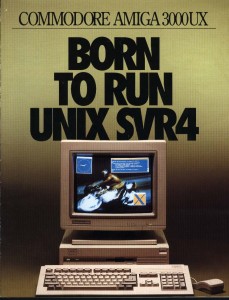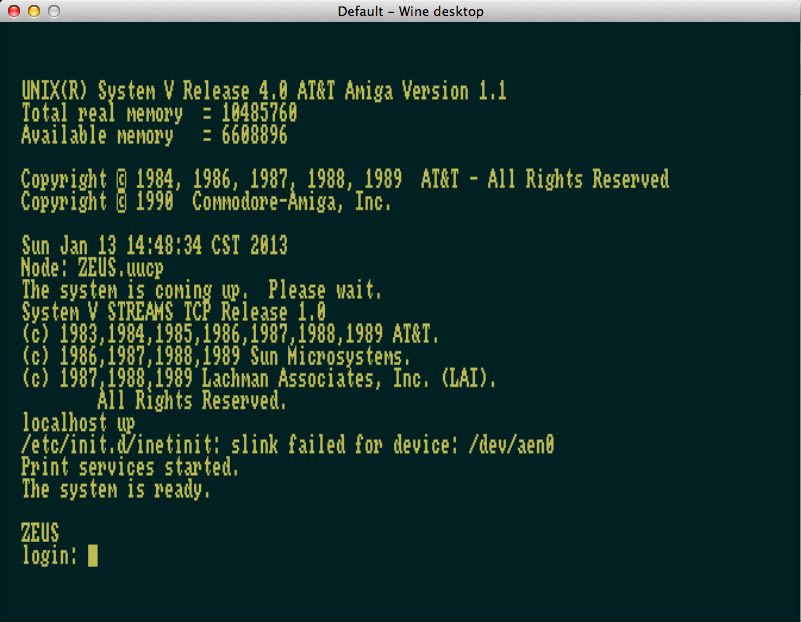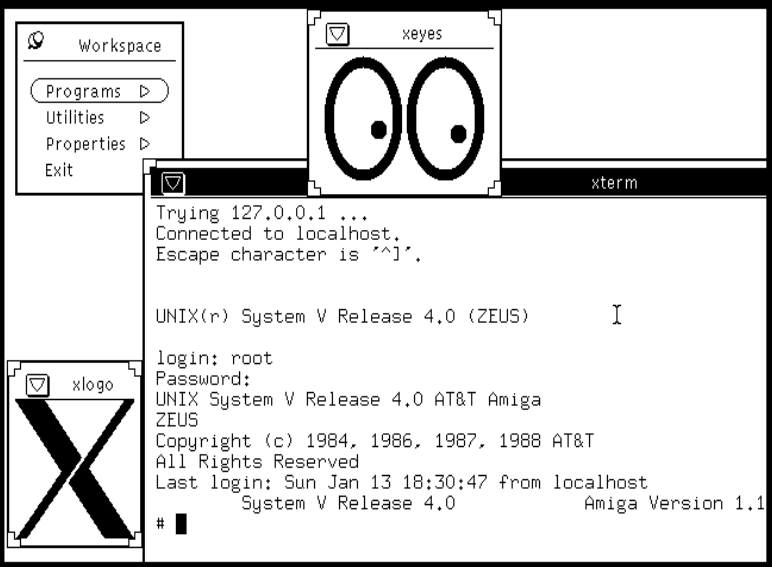Back in 1990 Commodore took the Amiga in a new direction with it’s new Amiga 3000, by commissioning a port of A&T SYSV Unix to the Amiga. Taking advantage of the 3000’s 68030 CPU and 68881 Math coprocessor, along with its integrated SCSI controller. It certainly was the hallmark of typical UNIX machines of the time.
When originally announced there was some big interest in the platform by SUN, as their original SUN-1, SUN-2 & SUN-3 lines of workstations were all 68000 based machines, and being able to rebrand a mass produced Commodore model would have been a good thing, however the deal ultimately fell through.  The machine would have been the Amiga 3500, which later became the Amiga 3000T.
Another thing to keep in mind is that SUN’s SYSV (Solaris) was targeted to the SPARC processor, and it is unlikely that they would benefit from selling a 68030 based machine in 1991.
Typical of the time, AMIX installs from a set of boot floppies, and then pulls the rest of the installation from a tape drive, such as the A3070.
AMIX was released at a time when the UNIX world was rapidly moving to RISC processors, SUN had their SPARC, SGI had their MIPS, IBM and their POWER, Motorola built UNIX machines around their 88000 RISC processor, NeXT was also going to move to the 88000 until they gave up making their own hardware and shifted to a software company. Â So who would want a then dated 68030 based machine when the industry had made their first steps into the world of RISC computing.
So how does it measure up?  Well it is SYSV, and if you’ve seen one, well honestly you’ve seen them all.  What is kind of neat is that AMIX includes OpenLook and a C compiler, which is kind of a rarity for the period.
Another flaw was that when the 68040 processor was released it’s MMU was incompatible with the 68030, and the VM subsystem for any UNIX would have to be rewritten. Â While NetBSD can run on both the 68030 and 68040, AMIX never was updated, and so it can only run on 68030 based machines.
AMIX never did get any critical traction, and slipped into oblivion with the death of Commodore.
Up until recently it was impossible to run AMIX in any emulator, but there has been a lot of work on the ARANYM and Pervious emulators which included doing 68030 MMU support for the possibility of running early versions of NeXTSTEP. Toni Wilen was able to adapt their work onto WinUAE and it is not possible to run AMIX.!
Reading through this thread,  I was able to put together the needed bits, and get it running under CrossOver, by using the pre-configured settings for WinUAE, and replacing the exe with the new beta exe, the supplied hard disk image from amigaunix.com and I was up and running in no time!  The only real change from the config was to change the SCSI ID of the hard disk from 0 to 6.
The default password is wasp. Â I thought it was kind of interesting that AMIX includes ‘dungeon’. Â really cool!
I am unsure of how to enable the high resolution graphics, but sadly the Amiga known for its multimedia capabilities, AMIX with stock graphics runs in monochrome. Â Such a major underwhelming thing.
Oh well, for anyone inclined you can now run AMIX, and enjoy another dead SYSV.




no ready-to-run package this time? oh well, i guess it’s easy to set up, i’m just used to your doing the dirty work. 😉 anyways, cheers for this, i’ve been wanting to try amix for a long-long time..
This is so amazing! Another system virtualized so people can play with it on modern hardware. I only wish one of Atari emulators would allow to run Atari SysV (ASV). Same goes for A/UX.
I imagine that the 68030 is better decoded that there is hope all the way around… Except on the Mac front as they tend to inject ‘drivers’ into the ROM to get around the floppies, I don’t think any of them emulated the SCSI …
Were any capable of running HD utils or whatever it was?
Yes, the mac emulators are pretty good on the SCSI front. Although A/UX is very picky on it’s own. I’m trying to get it moved to SCSI2CF or IDE2CF + SCSI2IDE and it fails miserably.
years ago I ran it from CF .. using one of those CF 2 IDE then an IDE to SCSI bridge…
I’m getting errors and freezes on this. Maybe I will try another make / model.
it was rather touchy to get installed and it could kill itself without too much provocation..
I want to say going from a 4GB CF card to a 1GB or 500MB helped a bunch..
A/UX is more like Xenix than like System 6, it wants to live in a small house.
The current Mac emulators do not fully emulate SCSI. Both Mini vMac and Basilisk II patch the ROM for floppy, hard disk, etc. Nor do they emulate the MMU, preventing AU/X from booting (as well as the lack of hardware)
However the Mac emulation in MESS has come along way. I’m not sure if it can boot AU/X yet, but it certainly is emulating the floppy controller varients and SCSI, as well as various graphics and sound chips, rather than just patching the ROM.
BasiliskII Build 142 on windows is your friend, it can emulate a SCSI bus very well, to the extent that you can attach real and emulated SCSI devices to the emulator using the ASPI layer provided by host, and with some tunning the Mac inside the VM will recognize almost all them.
Using the built-in Win7 VHD feature and an emulated CDROM like Alcohol or WinCDEMU, you can even install MacOS to a VHD file!!!
Using TotalMounter from KernSafe and its “RAW-HDD” emulation feature, you even can get a dd-able image that can be applied to a real Mac HDD to make it bootable. All that verified by me.
Since AU/X comes with a bootable CD, the only thing that is need by the OS and basilisk lacks really is the 68k MMU. On this sort maybe “Previous”, or MESS can do a better job that Basilisk.
That still doesn’t protect you from Basilisk patching the shit out of the ROM, so normal Mac OS doesn’t talk to the non-existant floppy controllers, but rather a virtual disk pretending to be a floppy. Or the lack of an MMU. Or lack of any controllers, for that matter.
Basilisk and friends work by patching the fuck out of the ROM so it doesn’t emulate hardware, it makes the OS work with it’s emulated interfaces. MESS is as close as we get. Not a chance.
Did you get winuae networking working?
Yes, I’ve even suggested to the author about SLIRP so it won’t rely on winpcap …
Sadly this is a 2 user version of AMIX so it is very limited in those regards.
Unix on Amiga, very interesting. It’s probably as you say though, the processor targeted was a bit too late for 1991.
A small correction: Sun’s OS at the time wasn’t SYSV-based and wasn’t called Solaris (all that happened years later), it was the BSD-based original SunOS (in Sparc version, as we know Sun had targeted 68k before 1990). My favorite Unix in 1991. SYSV-based systems were not very nice to work with back then, at least not those I had access to.
I thought SUN had already made the move off of BSD .. wow kind of funny they were shopping to Commodore of all people about doing a SYSV ..
Amiga on SPARC?
I’m sure the opportunities screwed up were.. monumental.